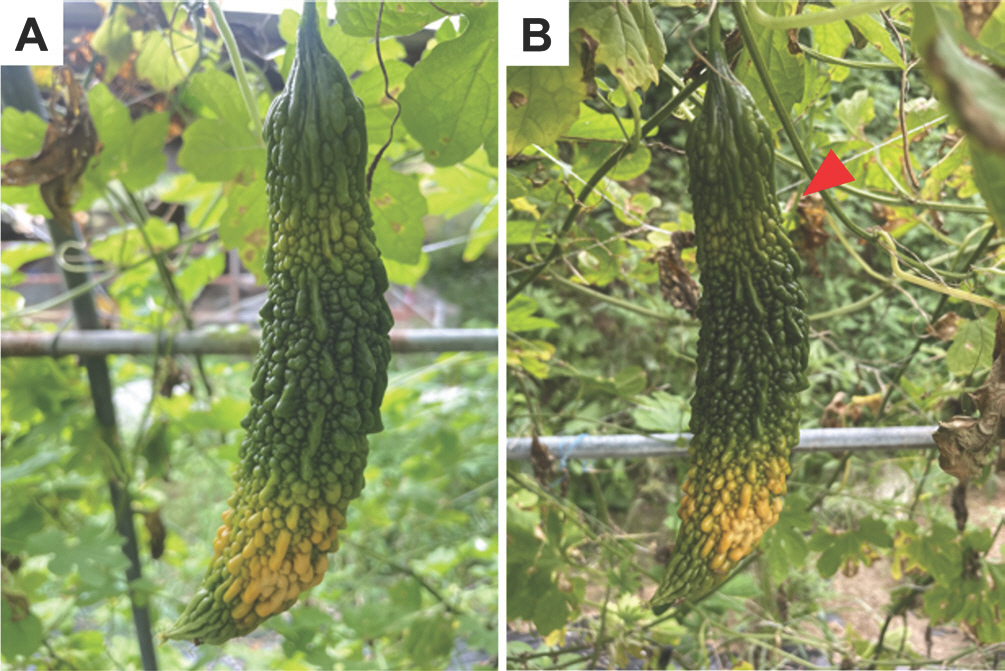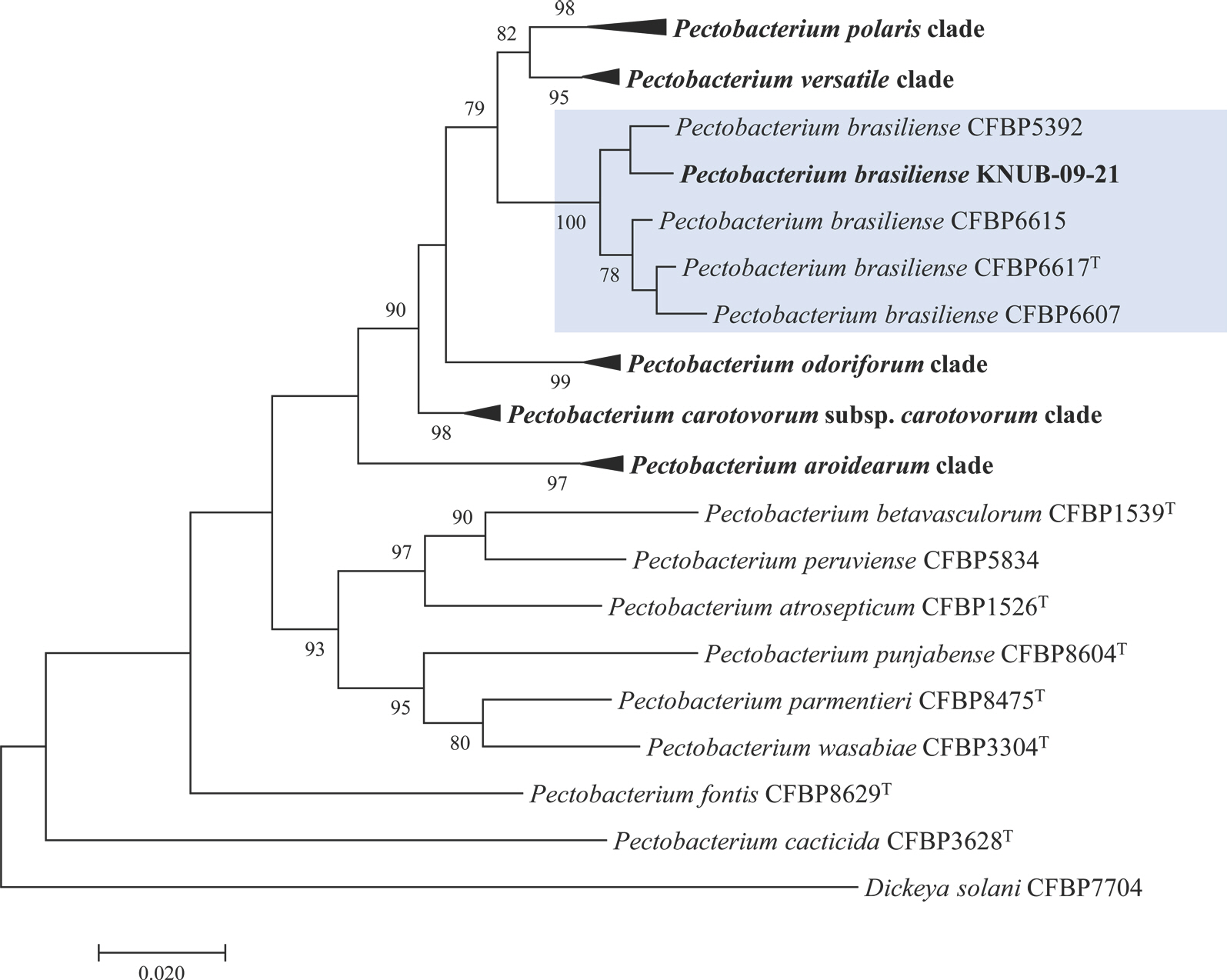Adeolu, M., Alnajar, S., Naushad, S. and Gupta, R. S. 2016. Genome-based phylogeny and taxonomy of the ŌĆśEnterobacterialesŌĆÖ: proposal for Enterobacterales ord. nov. divided into the families Enterobacteriaceae, Erwiniaceae fam. nov., Pectobacteriaceae fam. nov., Yersiniaceae fam. nov., Hafniaceae fam. nov., Morganellaceae fam. nov., and Budviciaceae fam. nov.
Int. J. Syst. Evol. Microbiol. 66: 5575-5599.


Appy, M. P., Vitor, L., Macedo, B. I. B., Ferreira-Tonin, M., Harakava, R. and Lanza, S. A. D. 2023. First report of
Pectobacterium brasiliense causing soft rot on Chicory (
Cichorium intybus subsp.
intybus) in Brazil.
Plant Dis. 107: 2214.

Barras, F., van Gijsegem, F. and Chatterjee, A. K. 1994. Extracellular enzymes and pathogenesis of soft-rot Erwinia.
Annu. Rev. Phytopathol. 32: 201-234.

Choi, I. Y., Kim, J. H., Lee, W. H., Park, J. H. and Shon, H. D. 2015. First report of black rot caused by
Phoma cucurbitacearum on
Momordica charantia in Korea.
Plant Dis. 99: 727.

Choi, O. and Kim, J. 2013.
Pectobacterium carotovorum subsp.
brasiliense causing soft rot on paprika in Korea.
J. Phytopathol. 161: 125-127.


Czajkowski, R., P├®rombelon, M. C. M., van Veen, J. A. and van der Wolf, J. M. 2011. Control of blackleg and tuber soft rot of potato caused by
Pectobacterium and
Dickeya species: a review.
Plant Pathol. 60: 999-1013.

Duarte, V., de Boer, S. H., Ward, L. J. and de Oliveira, A. M. R. 2004. Characterization of atypical Erwinia carotovora strains causing blackleg of potato in Brazil.
J. Appl. Microbiol. 96: 535-545.


Felsenstein, J. 1981. Evolutionary trees from DNA sequences: a maximum likelihood approach.
J. Mol. Evol. 17: 368-376.



H├®lias, V., Hamon, P., Huchet, E., Wolf, J. V. D. and Andrivon, D. 2012. Two new effective semiselective crystal violet pectate media for isolation of
Pectobacterium and
Dickeya.
Plant Pathol. 61: 339-345.

Hong, S.-M., Park, K.-T., Ten, L. N., Back, C.-G., Kang, I.-K., Lee, S.-Y. et al. 2023a. First report of soft rot caused by
Pectobacterium brasiliense on cucumber in Korea.
Res. Plant Dis. 9: 304-309.


Hong, S.-M., Ten, L. N., Park, K.-T., Back, C.-G., Waleron, M., Kang, I.-K. et al. 2023b.
Pectobacterium jejuense sp. nov. isolated from cucumber stem tissue.
Curr. Microbiol. 80: 308.



Hugouvieux-Cotte-Pattat, N., Condemine, G., Nasser, W. and Reverchon, S. 1996. Regulation of pectinolysis in. Erwinia chrysanthemi. Annu. Rev. Microbiol. 50: 213-257.
Hugouvieux-Cotte-Pattat, N., Condemine, G. and Shevchik, V. E. 2014. Bacterial pectate lyases, structural and functional diversity.
Environ. Microbiol. Rep. 6: 427-440.


Jeong, U. S., Kim, S. and Chae, Y.-W. 2020. Analysis on the cultivation trends and main producing areas of subtropical crops in Korea. J. Korea Acad.-Ind. Coop. Soc. 21: 524-535.
Jin, Y. J., Jo, D., Kwon, S.-W., Jee, S., Kim, J.-S., Raman, J. et al. 2022. A new approach using the SYBR green-based real-time PCR method for detection of soft rot
Pectobacterium odoriferum associated with kimchi cabbage.
Plant Pathol. J. 38: 656-664.




Kim, J.-H., Kim, J., Choi, I.-Y., Cheong, S.-S., Uhm, M.-J. and Lee, W. H. 2015. First report of anthracnose on bitter gourd caused by
Colletotrichum gloeosporioides in Korea.
Res. Plant Dis. 21: 32-35.

Koh, Y. J., Kim, G. H., Lee, Y. S., Sohn, S. H., Koh, H. S., Kwon, S. et al. 2012. Pectobacterium carotovorum subsp. actinidiae subsp. nov., a new bacterial pathogen causing canker-like symptoms in yellow kiwifruit. Actinidia chinensis. N. Z. J. Crop Hortic. Sci. 40: 269-279.
Kubo, H., Kanehashi, K., Shinohara, H., Negishi, H., Matsuyama, N. and Suyama, K. 2009. Bacterial soft rot, a new disease of balsam pear (Momordica charantia L.) caused by Erwinia carotovora subsp. carotovora. Jpn. J. Phytopathol. 75: 173-175.
Kwon, J.-H. and Jee, H.-J. 2005. Rhizopus soft rot on Momordica charantia caused by Rhizopus stolonifer in Korea. Res. Plant Dis. 11: 204-207. (In Korean)
Ma, B., Hibbing, M. E., Kim, H.-S., Reedy, R. M., Yedidia, I., Breuer, J. et al. 2007. Host range and molecular phylogenies of the soft rot enterobacterial genera
Pectobacterium and
Dickeya.
Phytopathology 97: 1150-1163.


Mansfield, J., Genin, S., Magori, S., Citovsky, V., Sriariyanum, M., Ronald, P. et al. 2012. Top 10 plant pathogenic bacteria in molecular plant pathology.
Mol. Plant Pathol. 13: 614-629.



Maung, C. E. H., Choub, V., Cho, J.-Y. and Kim, K. Y. 2022. Control of the bacterial soft rot pathogen,
Pectobacterium carotovorum by
Bacillus velezensis CE 100 in cucumber.
Microb. Pathog. 173: 105807.


Nabhan, S., de Boer, S. H., Maiss, E. and Wydra, K. 2012. Taxonomic relatedness between
Pectobacterium carotovorum subsp.
carotovorum, Pectobacterium carotovorum subsp.
odoriferum and
Pectobacterium carotovorum subsp.
brasiliense subsp. nov.
J. Appl. Microbiol. 113: 904-913.


Ûztürk, M. and Umar, A. R. 2022. Occurrence, identification, and host range of
Pectobacterium brasiliense causing soft rot on seed potato tubers in Turkey.
J. Plant Dis. Prot. 130: 1-12.


Park, K.-T., Hong, S.-M., Back, C.-G., Kim, S. Y., Lee, S.-Y., Kang, I.-K. et al. 2022. First report of
Pectobacterium brasiliense causing soft rot on graft cactus in Korea.
Res. Plant Dis. 28: 172-178.


Park, K.-T., Ten, L. N., Back, C.-G., Hong, S.-M., Lee, S.-Y., Han, J.-S. et al. 2023. First report of melon soft rot disease caused by
Pectobacterium brasiliense in Korea.
Res. Plant Dis. 29: 310-315.


P├®rombelon, M. C. M. 2002. Potato diseases caused by soft rot erwinias: an overview of pathogenesis.
Plant Pathol. 51: 1-12.


Portier, P., P├®dron, J., Taghouti, G., Fischer-Le Saux, M., Caullireau, E., Bertrand, C. et al. 2019. Elevation of
Pectobacterium carotovorum subsp.
odoriferum to species level as
Pectobacterium odoriferum sp. nov., proposal of
Pectobacterium brasiliense sp. nov. and
Pectobacterium actinidiae sp. nov., emended description of
Pectobacterium carotovorum and description of
Pectobacterium versatile sp. nov., isolated from streams and symptoms on diverse plants.
Int. J. Syst. Evol. Microbiol. 69: 3207-3216.


Sławiak, M., van Beckhoven, J. R. C. M., Speksnijder, A. G. C. L., Czajkowski, R., Grabe, G. and van der Wolf, J. M. 2009. Biochemical and genetical analysis reveal a new clade of biovar 3
Dickeya spp. strains isolated from potato in Europe.
Eur. J. Plant Pathol. 125: 245-261.


Waleron, M., Waleron, K., Podhajska, A. J. and Łojkowska, E. 2002. Genotyping of bacteria belonging to the former
Erwinia genus by PCR-RFLP analysis of a
recA gene fragment.
Microbiology 148: 583-595.


Wu, Y.-M., Wang, L.-H. and Chu, C.-C. 2023. First report of
Dickeya dadantii causing bacterial soft rot of
Thaumatophyllum bipinnatifidum in Taiwan.
Plant Dis. 107: 552.








 PDF Links
PDF Links PubReader
PubReader ePub Link
ePub Link Full text via DOI
Full text via DOI Download Citation
Download Citation Print
Print






